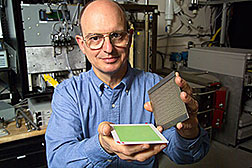- Number 425 |
- October 27, 2014
Idaho engineer is energy Renaissance man

Idaho National Laboratory Fellow
Steve Herring retired from INL last
month after a storied career studying
an extensive variety of energy and
nuclear topics.
From superconducting magnets to high-temperature hydrogen production, and from submerged nuclear reactors to liquefied-natural-gas (LNG) vehicles, Steve Herring, a Laboratory Fellow at DOE's Idaho National Laboratory, has studied an extensive variety of energy and nuclear topics.
Herring got his start in engineering as a 13-year-old, building a linear induction electric motor while in the hospital recovering from an appendectomy. Drawing on his dual degrees in electrical and mechanical engineering from Iowa State (1971), Herring served in the U.S. Army Electronics Command Laboratories and studied at the Swiss Federal Institute of Technology in Zürich, Switzerland.
While there, Herring studied nuclear engineering for a year, taking courses taught only in German. Upon returning to the U.S., he earned his doctorate in nuclear engineering from the Massachusetts Institute of Technology and began working at INL in 1979.
Herring's first position at INL was part of the Fusion Safety Program, which conducted research into possible safety issues of nuclear fusion reactors. In 1987, he served as a visiting scientist at the premier nuclear research center in Germany, where he studied accidents in superconducting magnets. That work led to research on the safety of transporting and using liquefied natural gas as a fuel for trucks and buses.
Turning increasingly to fission research in the early '90s, Herring investigated high-burnup fuels for light water reactors and the use of thorium-uranium mixtures for reduced plutonium production and converting long-lived isotopes into energy and much shorter-lived fission products.
Other research led to a patent in 1993 for the design of a submerged nuclear reactor, to be located 20 to 50 kilometers offshore and 50 to 200 meters beneath the surface. The Submerged Power Station would be manufactured, refueled and decommissioned in a central facility and transported to the generating site for a 3- to 5-year operating cycle. The subsea location would have enhanced cooling, seismic, tsunami and hurricane advantages.
What may be the highlight of Herring's research is his work on the High Temperature Steam Electrolysis hydrogen production project, which centered on the use of a new prototype of reactor being vigorously researched at INL — the Very High Temperature Reactor — to produce hydrogen.
In the future "hydrogen economy" envisioned by energy researchers, the hydrogen from electrolysis could be used as a vehicle fuel. In the nearer term, it could be used as a feedstock for the production of synthetic diesel, gasoline and jet fuel. For present-day purposes, the produced hydrogen can be used to upgrade heavy crude oil, producing conventional transportation fuels.
Herring's designation of INL Laboratory Fellow, the lab's top scientific achievement, recognizes an individual's outstanding contributions to the scientific and engineering community. Reflecting on his time at INL, Herring noted the unique nature of life in Idaho Falls.
"This is a small town in the corner of Idaho, and it's not a very populated area," he said. "However, as the home of INL, Idaho Falls attracts interesting people from all over the world. That's one reason that I've really enjoyed my career here and hope to keep in contact after retiring."Submitted by DOE's Idaho National Laboratory
